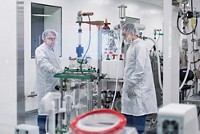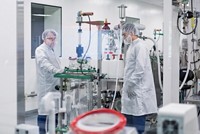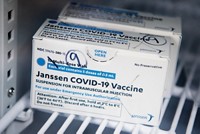Advertisement
Grab your lab coat. Let's get started
Welcome!
Welcome!
Create an account below to get 6 C&EN articles per month, receive newsletters and more - all free.
It seems this is your first time logging in online. Please enter the following information to continue.
As an ACS member you automatically get access to this site. All we need is few more details to create your reading experience.
Not you? Sign in with a different account.
Not you? Sign in with a different account.
ERROR 1
ERROR 1
ERROR 2
ERROR 2
ERROR 2
ERROR 2
ERROR 2
Password and Confirm password must match.
If you have an ACS member number, please enter it here so we can link this account to your membership. (optional)
ERROR 2
ACS values your privacy. By submitting your information, you are gaining access to C&EN and subscribing to our weekly newsletter. We use the information you provide to make your reading experience better, and we will never sell your data to third party members.
Vaccines
No magic wand
by Bibiana Campos-Seijo
November 28, 2020
| A version of this story appeared in
Volume 98, Issue 46
Three COVID-19 vaccine research and development groups—BioNTech and Pfizer, Moderna, and AstraZeneca and the University of Oxford—have now provided preliminary data confirming that the vaccines they are developing show high efficacies. That is excellent news, and the outlook to have a viable, widely available vaccine in 2021 is good.
It feels as if the light at the end of the tunnel just got a bit closer, but significant logistical obstacles remain. Once the vaccine is ready, we have to manufacture enough doses, and then store, transport, and distribute them.
I was listening to an interview with Margaret Hamburg, former commissioner of the US Food and Drug Administration, and even though she was upbeat about the progress that has been made—she used terms such as “unprecedented” and “extraordinary” to refer to how quickly the vaccines have been developed—she touched on the many issues still to be worked through.
When it comes to manufacturing, the main problem is volume. We are talking about hundreds of millions of doses initially. Once the companies secure emergency use authorizations from the FDA, Hamburg said, the question becomes what communities we should target. Frontline health-care workers, first responders, essential workers, and others who are most at risk (such as older adults) will need to be prioritized.
Storage and transport have also been flagged as problematic because the vaccines must be kept cold. Pfizer’s vaccine, for example, needs to be stored at –70 °C, while Moderna’s needs a milder –20 °C. Predicting short supplies of dry ice, a number of organizations have started to work on potential solutions.
Distributing the vaccine won’t be easy, either, especially given that all three vaccines require two shots to be effective.
And, let’s face it, not everyone will want to get it. A vaccine is “not a magic wand,” Hamburg said. “Even the world’s most safe and effective vaccine won’t make a difference if people don’t trust it and won’t take it.” It’s as simple as that, and no amount of reasoning or information is likely to change that. Some people will allege that corners have been cut since the vaccines will be available in record time. Others will argue that we don’t know enough about the level and duration of protection that the vaccines afford. And just as the use of masks has been politicized, I expect to also see further politicization of the vaccines once they are available.
And then there is the antivax movement—made up of individuals, mainly from Western countries, who oppose vaccination because of perceived risks. It preceded COVID-19 and has unfortunately gained ground.
The movement has successfully spread disinformation via social media and other means, contributing to underimmunization in certain locations and communities. Take measles, for example. One of the world’s most contagious diseases, measles also disproportionately affects children under 5. Though a vaccine has existed since 1963 that is known to be safe and 97% effective, there have been recent outbreaks in the US and elsewhere. The US Centers for Disease Control and Prevention reported 1,282 cases last year, the highest number since 1992.
We can’t afford another situation where cases are rising and people are dying despite the availability of a vaccine.
Scrupulously following the regulatory framework for vaccine development and having “science . . . lead the way,” as Hamburg said, will be of paramount importance to end this pandemic. And clear and direct communication with the public will be vital to ensure compliance with vaccination protocols. Other than that, I’m curious to see which of the three vaccines will make it over the finish line first.
Views expressed on this page are those of the author and not necessarily those of ACS.





Join the conversation
Contact the reporter
Submit a Letter to the Editor for publication
Engage with us on Twitter